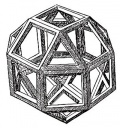Pierre-François Hugues d'Hancarville
From The Art and Popular Culture Encyclopedia
|
Related e |
|
Featured: |
Pierre-François Hugues d'Hancarville is a French pseudo-aristocrat (Nancy 1719 - Padua 1805). Son of a bankrupt cloth merchant of Nancy, Hancarville was born Pierre-Francois Hugues, adding the title ‘Baron’ and the aristocratic surname Hancarville himself. An amateur art dealer he introduced William Hamilton to the Porcinari family, whose collection of antiquities Hamilton purchased forming the basis of the collection that was subsequently sold to the British Museum. With Hamilton he edited Les Antiquités d'Hancarville published in 4 volumes 1766-67, a collection of vases and other antiquities from the excavations at Herculaneum and Pompeii; one of the most beautiful books ever made, it was influential in informing the emerging taste for neoclassicism and inspired reproductions from pottery manufacturers such as Wedgwood. In 1769 Hancarville was forced to flee his creditors in Naples.
Hancarville also produced two pornographic volumes under fictitious imprints:Monumens de la vie privée des XII Césars d’apres une Suite de Pierres et Medailles Gravées sous leur regne (Capri, chez Sabellus, 1780)
Monumens du culte secret des dames romaines ("Rome. De l'Imprimerie du Vatican, 1787")
These were widely pirated, in variously incompetent editions, during his lifetime.
References
- Sebestian Schutze: The Complete Collection of antiquities from the Cabinet of Sir William Hamilton, Taschen, 2004.

